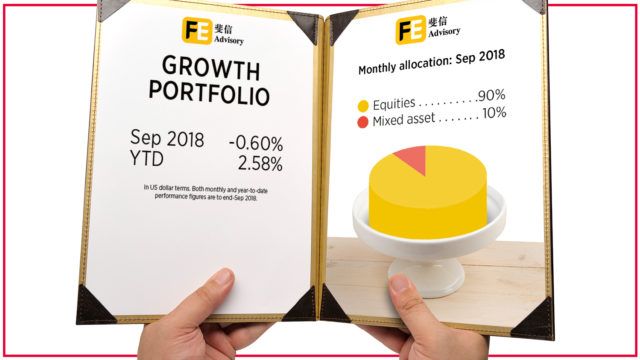Each month we feature the allocation in one of the three portfolios offered by FE Advisory Asia: Cautious, Balanced and Growth. Data is included to show how well the portfolio has done compared to the previous month and year-to-date so that readers can get a sense of performance.
Additionally, Luke Ng, senior VP of research at FE Advisory Asia, provides a concise analysis on macro events and their impact on the portfolio.
A breakdown of the Growth portfolio at the end of September 2018*. Performance figures are in the menu image above.


Luke Ng, FE Advisory Asia
How did the market perform in September?
It was a relatively subdued month for equity investors with some markets posting slight losses while others managed to scrape together some slight gains. The strongest performing developed market was Japan, where victory for Shinzō Abe in the leadership elections for the LDP effectively meant that he will remain as prime minister for the next three years, providing greater stability and visibility of policy. UK equities also posted positive returns despite Brexit uncertainty continuing to drag on sentiment and resulting in a devaluation of the sterling. Nevertheless, it still ended up as a positive push to equities, given a lot of the companies in the FTSE 100 make most of their money outside of the UK.
The US ended the month broadly flat, despite data showing that wages are now growing at the fastest rate since 2009. Industrial activity remained robust, showing little impact from the ongoing trade war with China.
Emerging markets in contrast fell heavily at the start of the month before recovering, as tensions in the ongoing trade talks between China and the US remained high. September also saw a rally in oil prices due to concerns over US sanctions on Iran. That resulted in a hit on India equities, as worries intensified over inflation and a widening trade deficit.
Among fixed income, 10-year US treasury yields rose in September after the US Fed hiked interest rates for the eighth time. Emerging market debt stablised as the Turkish central bank raised interest rates to 24%, significantly higher than what the market expected. Corporate bonds, in particular high yield, did well despite mixed performance across sectors.
How did the Growth portfolio perform?
The FE growth portfolio fell 0.60% in September in US dollar terms. The JPMorgan Japan (Yen) Fund was the best performing fund in the portfolio amid the relative strength of Japanese equities. To enhance our portfolio diversification benefit, we had some energy exposure in the portfolio and this also helped on the back of rising oil prices.
With bias towards Asia equities, it was not a particularly good month for us, especially one of our core Asia equity holdings with a stronger focus in India. Having said that, some of our holdings invested in the region managed to do well, namely a strategy primarily investing into China dividend stocks, which posted positive returns for the month and outperformed the market and peers. Lastly, our European exposure through Jupiter, which has done well consistently over the long term, did underperform in September due to the funds’ underweight in UK and financials and an overweight in Germany.
FE Advisory Asia portfolio performance
| Jan 2018 | Feb 2018 | Mar 2018 | Apr 2018 | May 2018 | June 2018 | YTD | |
| Cautious | 1.43% | -1.58% | -0.14% | 0.06% | 0.39% | -0.52% | 0.39% |
| Balanced | 3.64% | -2.68% | -0.18% | 0.44% | 1.22% | -0.96% | 0.75% |
| Growth | 5.19% | -3.60% | -1.17% | 0.63% | 1.75% | -1.22% | 1.36% |
| July 2018 | Aug 2018 | Sept 2018 | YTD | ||||
| Cautious | 0.65% | -0.17% | -0.43% | 0.05% | |||
| Balanced | 1.99% | 1.12% | -0.59% | 2.52% | |||
| Growth | 2.90% | 0.29% | -0.60% | 2.58% |

















